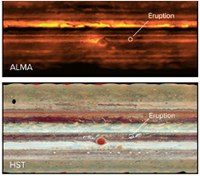The Solar System at Millimeter Wavelengths: Jupiter
 Imke det Pater et al. obtained the first maps of Jupiter at 1–3 mm wavelength with ALMA in early January 2017, just days after an energetic eruption in the southern hemisphere was reported by the amateur community, and ~2-3 months after the detection of similarly energetic eruptions in the northern hemisphere. Their ALMA observations probe below the ammonia cloud deck and show that the erupting plumes in the South Equatorial Belt bring up ammonia gas from the deep atmosphere. While models of plume eruptions that are triggered at the water condensation level explain data taken at uv–visible and mid-infrared wavelengths, these ALMA observations provide a crucial, hitherto missing, link in the moist convection theory by showing that ammonia gas from the deep atmosphere is indeed brought up in these plumes. Contemporaneous Hubble Space Telescope data show that the plumes reach altitudes as high as the tropopause. The authors suggest that the northern hemisphere plumes also rise up well above the ammonia cloud deck and that descending air may dry the neighboring belts even more than in quiescent times.
Imke det Pater et al. obtained the first maps of Jupiter at 1–3 mm wavelength with ALMA in early January 2017, just days after an energetic eruption in the southern hemisphere was reported by the amateur community, and ~2-3 months after the detection of similarly energetic eruptions in the northern hemisphere. Their ALMA observations probe below the ammonia cloud deck and show that the erupting plumes in the South Equatorial Belt bring up ammonia gas from the deep atmosphere. While models of plume eruptions that are triggered at the water condensation level explain data taken at uv–visible and mid-infrared wavelengths, these ALMA observations provide a crucial, hitherto missing, link in the moist convection theory by showing that ammonia gas from the deep atmosphere is indeed brought up in these plumes. Contemporaneous Hubble Space Telescope data show that the plumes reach altitudes as high as the tropopause. The authors suggest that the northern hemisphere plumes also rise up well above the ammonia cloud deck and that descending air may dry the neighboring belts even more than in quiescent times.
Image: Ammonia in the Jovian atmosphere (de Pater et al.).
Publication: Imke de Pater (University of California, Berkeley) et al., First ALMA Millimeter-wavelength Maps of Jupiter with a Multiwavelength Study of Convection, Astronomical Journal, 158, 139 (October 2019).
NRAO Press Release: Radio Jupiter: Seeing Giant Planet in a New Light




Connect with NRAO